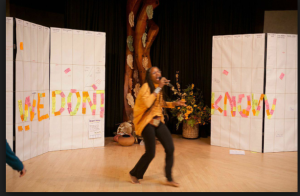By the standards of a conference, the New Story Summit (NSS) at Findhorn was a tremendous success. It featured a culturally diverse line-up of speakers who illuminated, both through the content of their speeches and also through their authenticity and presence, the deep crisis of our civilization and the possibility of its healing. Grief, despair, and anguish were allowed space alongside hope and inspiration; systems change and personal change were intimately acquainted.
At the same time, even though nearly everyone there would affirm that it was a fantastic conference, there was still an unusually strong undercurrent of discontent that revealed the limitations and perhaps the obsolescence of that thing we call a “conference.” People wanted it to be more than a conference, however fantastic. The incorporation of quite a few ceremonies officiated by indigenous people, as well as the invocation of a “new story” in the title, hinted: this can be more. There seemed to many to be a disconnect between its content and its form – new story content in an old story container. This, despite the fact that the organizers pushed the boundaries of the format to the very edge of their comfort zone, including nearly two days of Open Space technology, and running the whole thing on a gift model (with no set fee). For them, this was a radical break from long-established practice.
The first item of discontent that I saw was impatience with, as one angry voice from the audience put it, “being talked at for [the first] two-and-a-half days.” Ordinarily, that is what one expects at a conference. There was a program announced in advance, complete with speakers, around the topic of a new story – what else would anyone expect? There were even long breaks for discussion and integration. So, the quite palpable discontent arose not because this was a particularly oppressive conference, but perhaps for the opposite reason: the topic and looser format liberated the desire for something radically different.
It reminded me of the Soviet Union under Glasnost. When the oppressive apparatus of the Soviet state was lifted just a little bit, the simmering discontent within that society had the opportunity to erupt. With a little press freedom, what was long unspeakable was finally spoken, shouted; the lies that everyone pretended to believe became items of ridicule, and the inhibitions built on those lies evaporated. What followed was a period of chaos, a “space between stories” in which that society, lacking for a time a strong identity, became extremely vulnerable to predatory stories from the outside (neoliberal capitalism, for example) and to ruthless bullies and kleptocrats from within. It took a decade before a new story of the people began to emerge.
Similarly, at the NSS, the invocation of a “new story” along with the non-ordinary expectations triggered by the gift model, as well as, perhaps, a general readiness for something different among so many attendees, created conditions in which the latent discontent with the normal conference model rose to the surface. The usual inhibitions that prevent disruptive behavior were weaker, and at several moments it looked like the whole thing might tip into chaos.
If that had happened, the results might have mirrored in certain respects the situation in post-Soviet Russia, descending at first into a “dictatorship of the loudest.” For there was not an immediately available alternative structure to replace the one created by the organizers, nor do we even know what the successor to the Conference will look like. What was present, though, was a lot of resentment, impatience, anger at not being heard, and desire to find one’s voice, along with a vast reservoir of training in compassionate listening, nonviolent communication, council processes, meditation, inclusive decision-making methods, and other socially transformative practices. The ingredients for both a descent into chaos, and emergence into a new kind of order, were all there.
The gathering did not take this path, and the reasons why are illuminating. There were fundamentally two: the organizers were not willing to let go, and the participants were not willing to let go either. What the conference revealed to me (and I realize that this too is a story I’m constructing) is that our civilization has not quite yet reached the point of readiness for a new story.
The unwillingness to let go manifested each time the discontent, the chaos, and the rawness began to emerge. The organizers contained each outbreak through various interventions that amounted to a direct or indirect assertion of authority, for example by appealing to “respect for the schedule.” This was not because they are authoritarian control freaks! From what I saw, all of them are on a deep journey of personal transformation and have done a lot of shadow work. It was that the structural role they occupied tends to bring out the inner control freak in anyone. They were juggling a lot of plates: the concerns of the Findhorn Board, the needs of the dining hall staff, and the desire to be fair to presenters who would be left out if the schedule were not followed, to name a few. Notice, though, how these concerns mirror those of anyone in a hierarchical position of authority; for example, the people running governments and corporations. Uncontained protests and political disruptions do indeed cause severe dislocations in the lives of ordinary people who, like the dining hall workers, are just trying to get to work on time.
The problem is not that law-and-order martinets have taken over the world. It is that our governing institutions are nearly irresistible in demanding of their functionaries that they maintain the boundaries on which those institutions depend. Tremendous pressures bear on them to keep things working: the flights on time, the roads safe, the lines short, the supermarkets full, the fuel prices low. In the role, one does as the role dictates. This is not even a problem really – boundaries are part of nature and of all cultures; they form the containers in which growth and evolution can happen. Eventually, though, the growth pushes up against the boundary, and the container that once protected now represses.
Beyond this structural consideration, to blame the organizers for putting emergence into safe, limiting boxes misses another important point. Who actually has the power? It is the participants; in the wide world, it is the public. The power of the authorities comes only with the acquiescence of everyone else. At the NSS, at each crucial moment when it looked like real emergence might happen (as distinct from the choreographed “emergence” of days 4 and 5), the audience abetted the attempts of the organizers to reestablish control, to manage the situation, for example by joining in the feel-good songs to abort the processing of conflicts that had surfaced, or in one instance, by spontaneously toning en masse to drown out voices of protest. Each person had the choice whether to comply or not, and the majority complied. Each person had the choice whether or not to organize non-compliance, and no one did. That tells me that underneath their complaining (which, when unaccompanied by action, is actually a symptom of acceptance of the relations of oppression) they were just as unwilling as the organizers to try something different. Whether organizer or participant, the leap of faith and courage required to step into the unknown is the same.
Please don’t take this observation as a castigation of the people at the NSS, whether organizers or participants. My point is not to suggest that anyone should have done better or differently. I see the whole thing as a barometer of our current state of disempowerment, our stuckness. I hope that by making it visible, we can loosen its hold.
Let me illustrate the above with a specific example. During the night between the first and second “day of emergence,” some provocateurs snuck into the hall and rearranged the sticky notes, which had marked the time slot and location of each offering on the Open Space grid, to spell the words, “We don’t know.” OK, let me confess, I was one of those provocateurs, along with Jodie Evans, founder of Code Pink, and two others, Will Scott and Shay Sloan. The intent of the prank was to offer a plea for humility, an acknowledgement that no one really knows what the new story is, or, if we do catch glimpses of it, how to get there from here. It was also an affirmation of the importance of embracing the unknowing, the chaos, and the emergence – something that many felt was lacking in the contained and structured grid of the officially scheduled “days of emergence” – and an invitation to let go and enter that realm. Finally, by violating some of the tacit protocols of a conference, it offered permission to defy more of them.
The reaction of the conference participants, when they assembled the next morning and saw the violation visited upon the grid, was decidedly mixed. Some welcomed it as a breath of fresh air, a possible watershed moment that would break open a stultifying old-story structure and send the conference into uncharted territory. Others saw it as an act of juvenile rebelliousness or even violence that disrespected the organizers, the elders of the conference, and the 18 months of hard work that went into creating the event. Chaos again loomed close, and for a moment the loudest and angriest voices dominated. One man boomed, “This was an act of violence!” No one wants to be on the side of violence. Soon, the usual orderliness was restored, as the facilitators circulated around the room giving participants the microphone.
Among the diversity of opinions being expressed, I noticed they had one thing in common: they all acceded to the primary authority that was holding the event. Those who wanted rawness, those who wanted a plunge into “we don’t know,” were still petitioning for it. But when “we don’t know” is held inside “we do know,” for example, held within a schedule that “knows” that it will be complete by 9:25, it isn’t real. Nor is any revolution that is contained under the auspices of those in control – the permitted protest in the designated Free Speech Zone. At the NSS, the basic relations of power that were the source of much of the discontent remained fundamentally unchallenged even by those who were among the discontented. When push came to shove, they were nearly as uncomfortable with “we don’t know” as the organizers were.
At one point during the session I took the microphone and observed, “We could stop complaining and reverse this prank in less than ten minutes. Or we could step into the unknown. But who decides that? Where is the power here?”
When we try to change the world by petitioning existing authorities, through means condoned by those authorities, to implement changes that are frameable within existing terms of discourse, then not much is going to change. We are still operating within, and therefore legitimizing, existing institutions and structures.
In the end, having exercised their discontent, the assembly docilely got back with the program. To be sure, many of those assembled were very much looking forward to the Open Space presentations scheduled for that day (which was why we made sure the prank was reversible) and were happy to have them restored. But even those who were fed up with the structure went along with it, and I wonder if part of the reason might have been fear of the plunge into chaos that precedes true emergence. In those few minutes of chaos we got a glimpse of how messy it can be, when all that has been hidden comes out, sometimes explosively; when the pretenses and niceties fall away; when uncomfortable truths, conflicts, and disagreements rise to the surface; when festering wounds are exposed to light. We are afraid of it, yet we crave it as well; we crave the healing that becomes possible. This assembly chose to keep the wounds covered in the end: tentatively peeling back the covering, peeking in, recoiling, covering them again. And perhaps, in the time and place of the conference, that was appropriate – it is not for me to dictate that, which is one reason why we didn’t push harder on our provocation, leaving it instead as an invitation and a temperature reading.
What transpired at the NSS is instructive, for it is in some ways a microcosm of society at large. In the face of the guns, jails, surveillance, and propaganda, we (meaning, probably, “I”) take refuge in the familiar safety of our apparent powerlessness, venting our discontent through well-contained acts of empty defiance. Grumbling and complaining, we assure ourselves that at least we don’t agree with what is happening (as if that would change anything, as if our disagreement would provide some measure of exculpation). Many, if not most, protests and marches conform quite amiably to the conditions set by the authorities: where it will start, when it will end, where it will go. Such events register as barely a blip on the radar screen; they are the empty rituals of an obsolete narrative. On those rare occasions when the protest gets out of hand and the unexpected emerges, such as in Gezi Park or Tahrir Square, the results are especially instructive. The people, having won, or having come within measurable distance of victory, know not what to do. In Egypt they did win: the police joined the protesters and the military refused to shoot. However, the period of ferment that would have been the natural next step of the revolution was aborted; instead, the people simply replaced an old authority with a new, and the existing habits and relationships of dominance and submission quickly reasserted themselves.
I am not saying no one should ever operate within existing institutions and structures. I am merely pointing out the habit of doing so. Nor am I saying there “should” have been a revolution at the NSS, or that the audience shouldn’t have acceded to the authorities holding the event. What would have happened? I don’t know. Would it have been a more powerful conference? I don’t know. Were the organizers in fact wise to quell – no thanks to me! – the chaotic energy in a gathering of this type? I don’t know that either.
But let me tell you something I do know. The existing institutions of our society are insufficient to the task of transitioning us to a sustainable world. They are products of the old, and propagate the status quo via the built-in dynamics of their structure – even when the people within them yearn for change. Organizations routinely take actions that nary a single person within the organization agrees with. It is necessary to disrupt these institutions, the habits they induce, and the stories on which they rest.
And! And, we must be careful in our disruption not to conform to even deeper stories that underlie our civilization; for example, the story of us versus them. Ours is a revolution of love. We seek to disrupt the dance of the oppressor and the oppressed, and enter into a new dance together. We look at each person, whatever their role, and know that I would do as you do, my brother, my sister, if I were in your shoes. We appreciate the impossible pressures those in power face – that anyone in a position of any privilege faces – in striving to reconcile their humanity with their position. We don’t castigate or vilify them, just as we don’t indulge in self-hate over the conflict minerals in our smart phones. We make our disruptions as an offering. If the offering is declined, we do not say, “What’s wrong with them?” We do not inhabit the smugness of thinking that if we were they, we would have done differently. Instead we see the response as a message, a temperature reading that reveals both the state of the public and the state of ourselves that the public mirrors. Integrating this information, the next step becomes clear. We are on a mapless trek, each step becoming visible only after the last has been taken. This is true whether or not the disruption is successful at bringing change; either way, we are entering the territory of We Don’t Know.
My gratitude and appreciation for the New Story Summit comes just as much from its shortcomings as from its successes. The organizers took on a lot by inviting such an incendiary mix of people, people who in various ways are impatient with existing institutions – including the institution of the Conference. It showed us where we are now, and where we want to go. As to how to get there, the conference made it clear that We Don’t Know.
But perhaps, digesting the experience of the New Story Summit, the next step at least will come into focus. Its revelation of the limitations of the Conference archetype – in particular the disconnect between new-story content and old-story structures – will surely feed in to the planning of future conferences, which will stand on its shoulders. What is exciting to me is the possibility that the NSS marks a transition into a different kind of gathering entirely, no longer a conference, but perhaps more like a festival or a retreat, or something that is all and none of these things, something new, something edgy, something experimental, something destined to succeed and to fail, and thereby to illuminate the next step beyond. What else can we hope for, as we explore this mapless place between stories?
On November 5, Charles Eisenstein will be joining Paul Selig as a featured guest for the live, interactive video course, “Raise Your Frequency: A Direct Encounter with Channeled Guides.” You can take part in this Evolver Learning Lab event either by purchasing the entire 5-part course or a single session. Click here to learn more.















